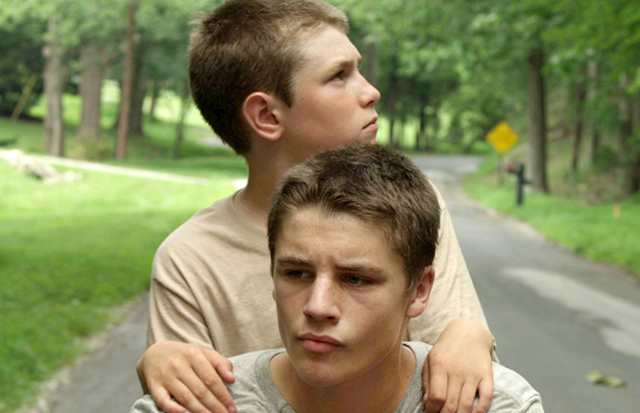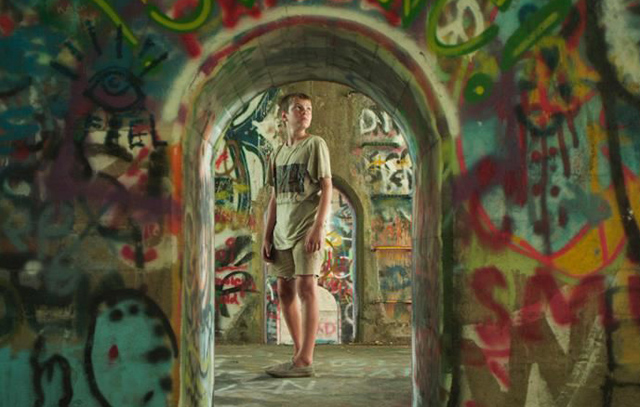CHICAGO – Patrick McDonald of HollywoodChicago.com appears on “The Morning Mess” with Dan Baker on WBGR-FM (Monroe, Wisconsin) on March 21st, 2024, reviewing the new streaming series “Manhunt” – based on the bestseller by James L. Swanson – currently streaming on Apple TV+.
Facing Life Transitions in ‘Hide Your Smiling Faces’
 Rating: 4.0/5.0 |
CHICAGO – The pain and passion of prepubescent youth and adolescence unravels in the excellent directorial debut of Daniel Patrick Carbone, “Hide Your Smiling Faces.” Carbone captures the isolation and meticulous boredom at a time of life when everything conspires to happen on a daily basis.
The film is a meditation, with shades of Terrence Malick-like contemplation. When the suicide of a troubled boy resonates a wave of reaction in a rural town, two brothers look inward to their own fragility. The soul-searching and almost beautiful ache of this snapshot is contained within the raw emotions exposed in the boys during their first experience of human mortality. The story is set in a property-less rural region of the country, a place where exploration is wide-open, both in territory and soul. The boys are both seekers, and as the reality of death and the bitter sameness of their lives unfolds, the very freedoms that they gained in their unique childhood suddenly begin to narrow.
Two brothers, young Tommy (Ryan Jones) and teenager Eric (Nathan Varnison) live in an expansive rural area with lakes, woods and nature. They hang out with Ian (Ivan Tomic), an angry boy from a harsh single parent home. Trying to impress his friends, Ian shows them his father’s handgun. When the boys start wrestling dangerously with the pistol, the father discovers them and cruelly punishes Ian in front of his friends.

Hanging On: Tommy (Ryan Jones, top) and Eric (Nathan Varnson) in ‘Hide Your Smiling Faces’
Photo credit: Tribeca Film
Ian runs from the scene, and ends up jumping from a high railway bridge to his death. The suicide shakes up the small community, especially Tommy and Eric. The reaction seems to be a test for them both, as they escalate a battle with Ian’s father – what begins with their dog loose on his land devolves into destruction and thievery. At the same time, Eric becomes more morose and challenges his brother. Nothing will ever be the same.
There is a tone established in the film that is fraught with danger, including the suicide – which is discovered by Eric – and the wasteful war between the brothers and Ian’s father. Combined with the boys-adventure-in-nature vibe that the setting naturally conveys, a life and death cycle is defined in every frame. The boys are constantly encountering nature of the highest and lowest forms, and constantly seem to be comparing it to their own existence.
The performances of the boys are essential in communicating this situation, and both child performers have a grasp on what the filmmaker is projecting through their characters. From the most vulnerable moments – like an animal-like cry from Eric after discovering Ian’s body – to their most vicious anger, Jones and Varnson embody the youthful and inappropriate angst that comes after a misunderstood tragedy.
The adults in the film are featured as lost souls that are complicit in the exposure of life’s cruelties. The founding of the gun, the suicide and the revenge war all have implications in the truth of mortality, and there is no guidance from the frustrated adults – one scene depicts the brother’s Mom as walking away rather than facing Eric’s condemnations. Adults are shown to be hapless, angry or addled, and the suspicion is that the isolated children might follow their joylessness.

Under the Bridge: Tommy in ‘Hide Your Smiling Faces’
Photo credit: Tribeca Film
There is no beginning-middle-end story in the film, just a reactive set of episodes after the suicide. Writer/director Daniel Patrick Carbone is able to find the natural grace in his woodland setting, which pushes against and highlights the human drama unfolding within it. The director has a eye for finding the places in the environment that reflected the emotions of the piece, including the bridge that Ian finalizes his plunge, which also serves as a significant location for a confrontation between the brothers.
The biggest, best strength of the film is the notion of crossing the bridge from childhood to real life. The truth of nature is that everything dies, and the truth of the emotional reaction to this mortality is a lesson that often separates a person from their youth. When that happens, keep the firearms locked up.
 | By PATRICK McDONALD |


